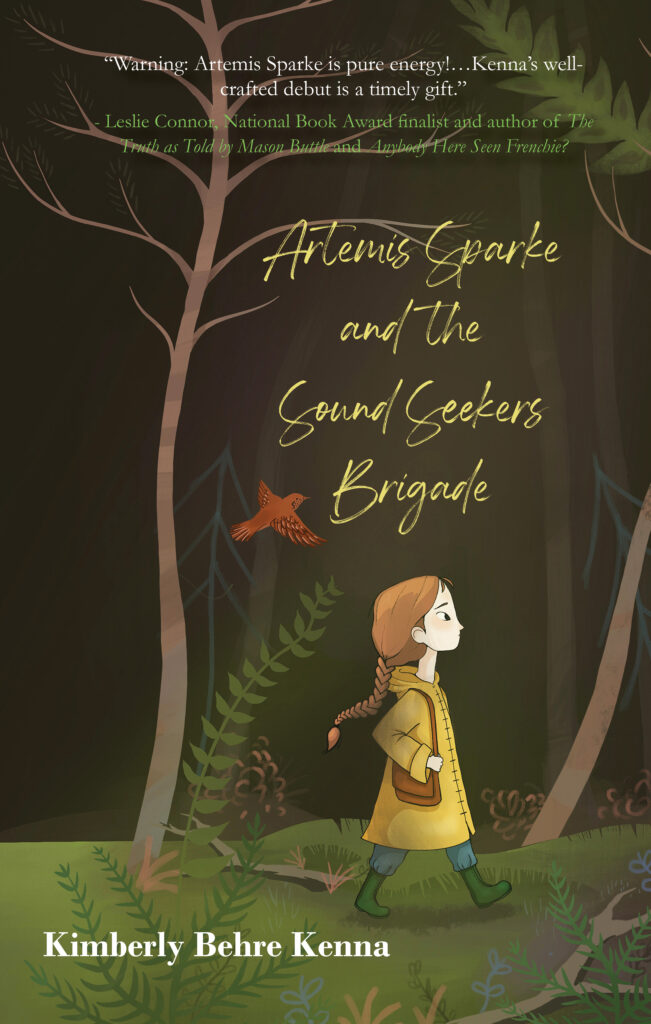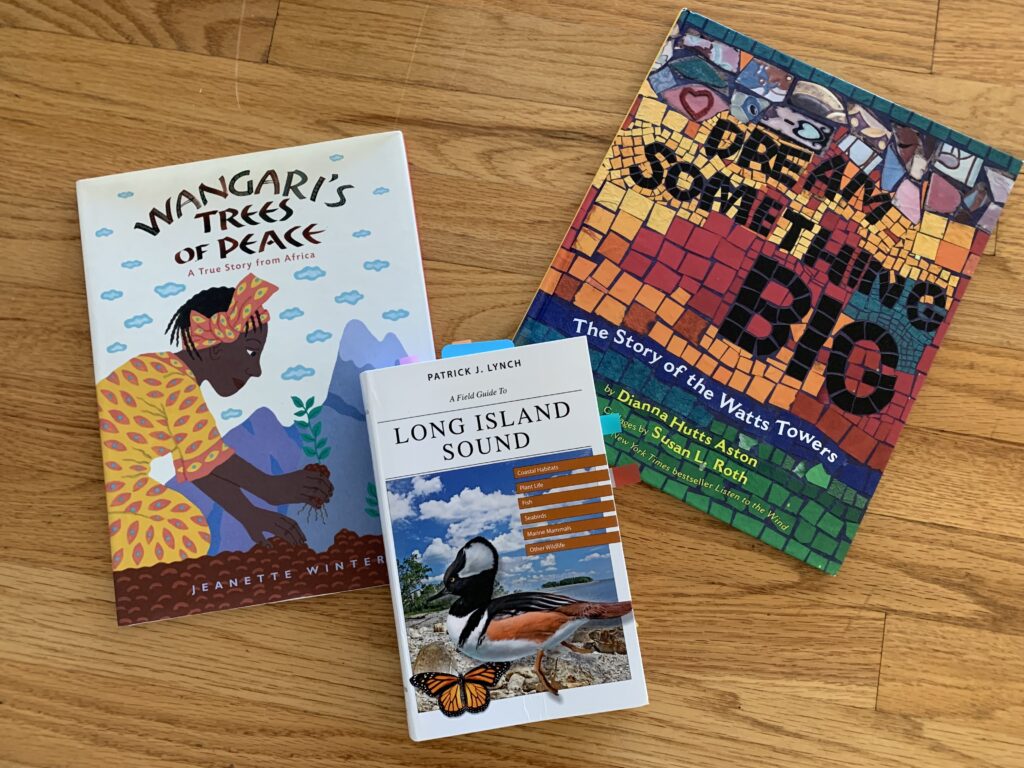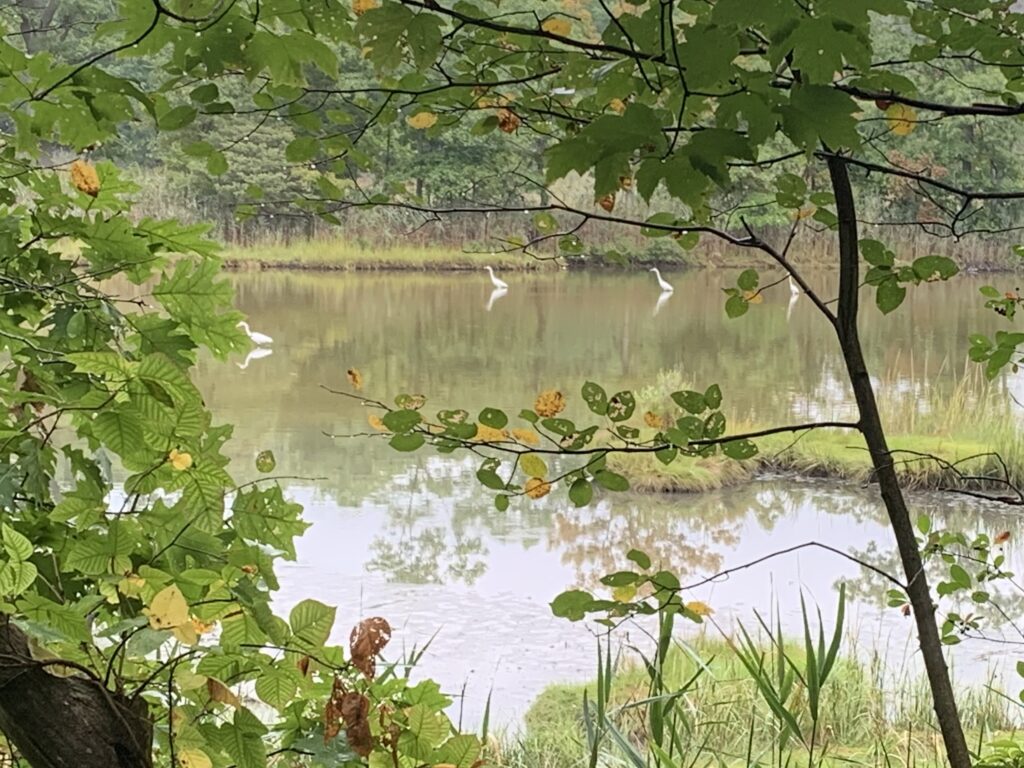Resurrecting Ghosts, a guest post by Kimberly Behre Kenna

As a kid in school, I didn’t do too well at memorizing facts. As a teacher, I discovered a better way to learn: Resurrect some ghosts.
I had the honor of teaching fifth graders about the ecology of Long Island Sound. Living in Connecticut, the Sound surrounds us, so we got to experience it first-hand. Of course, we used guidebooks and computers to research details about the fragile coast we lived on, but there was nothing like seeing my students crouching on a muddy ledge, wide-eyed, watching fiddler crabs scurrying in and out of burrows in a salt marsh.
Nature has always been a balm for me, and I was excited to share this space with my students. I watched them greet plants and creatures with questions and wonder as we hiked the trails that circled around the salt marsh and threaded through the adjacent woods. With a pair of binoculars in hand, my quietest students couldn’t contain their amazement when they spotted an osprey in its nest, and the most vocal students became speechless. Nature is transformative, and once the kids had joyfully immersed themselves in it, they were determined to protect it. But, they wondered, how can kids have an effect on problems like pollution and rising tides and declining bird populations that even adults can’t solve?
ADVERTISEMENT
ADVERTISEMENT

We decided to tap into the past to see if it might help us figure things out. We scoured picture book biographies to introduce ourselves to historic environmentalists. Besides well-known names like Rachel Carson and John Muir, we discovered many others whose work made a difference. Wangari Maathai planted trees in Kenya. Ding Darling drew satirical comics about wildlife conservation. Simon Rodia, an Italian immigrant, brought pride back to his LA community by constructing the ninety foot Watts Towers using recyclables. We learned that to be an environmentalist, you don’t need to be a scientist. Everyday people can have a positive impact on nature. Anyone can be an activist.
Here’s where the resurrection came in. Because we wanted to understand these powerful people better, we conjured up their ghosts. Each student chose one environmentalist and wrote a monologue addressing a current Long Island Sound issue from that ghost’s point of view. Embodying that person in this way required deep thinking about motivation and goals. Next, students took part in roundtable discussions as that environmentalist, problem-solving how working as a team could heal and help preserve Long Island Sound. George Washington Carver shared how he might help sustain plants against rising tides. Chico Mendes explained how strategies he used to help save the Brazilian rainforests might also help save our shoreline. The final culmination of our studies was to write and perform plays about these imagined scenarios. The first time I watched my students on stage, their passion moved me deeply. Seeing the stage lit up by the ghosts of deceased ecologists who were determined to help confused present-day humans save Long Island Sound made me realize how the process of artfully combining fact and fiction creates a medium that inspires all ages to care and take action.
So, it’s no surprise that when I began writing for children, my characters emerged from my experiences with them. The stories we created in the classroom were powerful for both the writer and the audience. I believed I could write novels that depicted power—nature’s power to astonish and heal, and especially the power of a single person’s voice.

One day as I hiked the Stony Creek trail in my hometown of Branford, the protagonist of my debut middle-grade novel, Artemis Sparke and the Sound Seekers Brigade, came to me as a whisper. Artemis, a stutterer, had strong opinions about the salt marsh that had been her sanctuary for years. There, she conversed with plants and animals without feeling self-conscious. But when she observed the area declining, she had to reach outside of her comfort zone and ask for help from some environmentalist ghosts in order to save it. Her whisper became a shout-out to me, asking how I imagined the experience of fighting for nature could transform her, just as it did for me and my students, and how it ultimately would allow her to embrace her voice just the way it was. Thanks to my life as a teacher, I knew historic figures from the past could help her do this.
ADVERTISEMENT
ADVERTISEMENT
As a child, I also struggled to embrace my voice. Witnessing the cycles and resilience of nature reminded me of the inherent power of authenticity. The more I wrote, the more I noticed these particular themes emerging in my stories. I hope kids will connect with Artemis and feel less alone and more certain that they can be seen, heard, and accepted just as they are.
When children form connections with birds, fish, or any wildlife, they often speak to them. In my book, Artemis believes she can hear her bird friend answer her questions. She chats with intelligent ghosts. Some may call this magical realism, but there are many who not only believe in ghosts but also believe that nature speaks to us. No matter what our beliefs, engaging kids in conversations about nature invites them into the web of interconnectedness. We are never alone. Artemis Sparke is an invitation for all ages to join a brigade or, even better, to rally up their own brigade and experience the power of resurrected voices.
Meet the author

After years as an adolescent and family counselor, and then as a fifth grade teacher of ecology and language arts, Kimberly returned to school for her MA in creative writing from Wilkes University. Her middle-grade novel, “Artemis Sparke and the Sound Seekers Brigade” was a finalist and received Honorable Mention in the 2019 Tassy Walden New Voices in Children’s Literature Competition. It will be published by Fitzroy Books 2/2/23. Another book in her Brave Girl Collection, “Jett Jamison and the Secret Storm” is forthcoming from Black Rose Publishing 8/3/23. A third in the collection, as yet unpublished, won second place in The Institute of Children’s Literature 2022 MG Mystery First Pages Contest. Her poems and short stories have been published in American Writers Review, Mused, Plumtree Tavern, and Rubbertop Review. Her full-length play, “Ana’s Hummingbird,” was given a staged reading at The Dramatists Guild in NYC. She’s a member of SCBWI and PEN America, and now devotes herself to writing full time. Connect with her at www.kimberlybehrekenna.com
About Artemis Sparke and the Sound Seekers Brigade
“…Artemis Sparke is pure energy! …Kenna’s well-crafted debut is a timely gift.” —Leslie Connor, National Book Award finalist and author of The Truth as Told by Mason Buttle and Anybody Here Seen Frenchie?
When Artemis Sparke has had it with humans, she heads to the nearby salt marsh to hang out with the birds, plants, and mollusks who don’t make a big deal of her stutter. The shoreline sanctuary is predictable, unlike her family and friends, and the data in her science journal proves it. But one day that data goes haywire, and her bird friend RT confirms it: the salt marsh is dying. Artemis discovers that the historic hotel where she lives with her mom may be part of the problem, but speaking up would mean confronting the cranky hotel owner who happens to be her mom’s boyfriend and boss. Artemis conjures up help from deceased ecologists, and as she works to untangle their clues, she finds family secrets that could be the key to saving the salt marsh but also may destroy her life as she knows it.
ISBN-13: 9781646033133
Publisher: Regal House Publishing
Publication date: 02/02/2023
Age Range: 9 – 12 Years
Filed under: Guest Post
About Amanda MacGregor
Amanda MacGregor works in an elementary library, loves dogs, and can be found on Twitter @CiteSomething.
ADVERTISEMENT
ADVERTISEMENT
SLJ Blog Network
Name That LEGO Book Cover! (#53)
Review of the Day: Being Home by Traci Sorell, ill. Michaela Goade
Exclusive: Vol. 2 of The Weirn Books Is Coming in October | News
Fighting Public School Book Bans with the Civil Rights Act
ADVERTISEMENT







